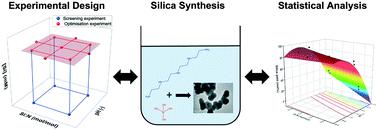当前位置:
X-MOL 学术
›
Mol. Syst. Des. Eng.
›
论文详情
Our official English website, www.x-mol.net, welcomes your feedback! (Note: you will need to create a separate account there.)
Designing bioinspired green nanosilicas using statistical and machine learning approaches
Molecular Systems Design & Engineering ( IF 3.6 ) Pub Date : 2021-3-4 , DOI: 10.1039/d0me00167h Luc Dewulf 1, 2, 3, 4 , Mauro Chiacchia 1, 2, 3, 4 , Aaron S. Yeardley 1, 2, 3, 4 , Robert A. Milton 1, 2, 3, 4 , Solomon F. Brown 1, 2, 3, 4 , Siddharth V. Patwardhan 1, 2, 3, 4
Molecular Systems Design & Engineering ( IF 3.6 ) Pub Date : 2021-3-4 , DOI: 10.1039/d0me00167h Luc Dewulf 1, 2, 3, 4 , Mauro Chiacchia 1, 2, 3, 4 , Aaron S. Yeardley 1, 2, 3, 4 , Robert A. Milton 1, 2, 3, 4 , Solomon F. Brown 1, 2, 3, 4 , Siddharth V. Patwardhan 1, 2, 3, 4
Affiliation

|
The in vitro bioinspired synthesis of silica, inspired from in vivo biosilicification, is a sustainable alternative to the conventional production of high value porous silicas. The short reaction time, mild reaction conditions of room temperature and its use of benign precursors make this an eco-friendly, economical and scalable route with great industrial potential. However, a systematic optimisation of critical process parameters and material attributes of bioinspired silica is lacking. Specifically, statistical approaches such as design of experiments (DoE) and global sensitivity analysis (GSA) using machine learning could be highly effective but have not been applied to this “green” nanomaterial yet. Herein, for the first time, a sequential DoE strategy was developed with pre-screening experiments to outline the feasible design space. A successive screening using 23 full factorial design determined that from the initially investigated three factors (the ratio of the reactant concentrations, pH, and precursor concentration), only the first two were statistically significant for silica yield and surface area. The subsequent concatenated optimisation using central composite design located a maximum yield of 90 mol% and a maximum surface area of 300–400 m2 g−1. Since for successful commercialisation, high yields and large specific surface areas are desirable, their simultaneous optimisation was also achieved with high predictability regression models. For complementation, a variance-based GSA was successfully applied to bioinspired silica for the first time. This method rapidly identified key parameters and interactions that control the physicochemical properties and provided insights in the wide parameter space, which was validated by the extensive DoE campaign. This work is the starting point in holistically modelling the multidimensional factor–response relationship over a large experimental space in order to complement efforts for resource-efficient product and process development and optimisation of bioinspired silica and beyond.
中文翻译:

使用统计和机器学习方法设计生物启发的绿色纳米二氧化硅
在体外二氧化硅的仿生合成,从激发体内生物硅化是高价值多孔二氧化硅常规生产的可持续替代方法。反应时间短,室温下反应条件温和以及使用良性前体使其成为具有巨大工业潜力的环保,经济和可扩展路线。然而,缺少对关键工艺参数和生物启发二氧化硅的材料属性的系统优化。具体而言,使用机器学习的统计方法(例如实验设计(DoE)和全局敏感性分析(GSA))可能非常有效,但尚未应用于这种“绿色”纳米材料。在此,首次通过预筛选实验开发了顺序DoE策略,以概述可行的设计空间。使用2 3进行连续筛选全析因设计确定,从最初研究的三个因素(反应物浓度,pH和前体浓度之比)来看,只有前两个因素在二氧化硅收率和表面积方面具有统计学意义。随后使用中央复合设计进行的串联优化确定最大产率为90 mol%,最大表面积为300–400 m 2 g -1。由于成功的商业化需要高产量和大的比表面积,因此还可以通过高可预测性回归模型实现它们的同时优化。作为补充,基于差异的GSA首次成功应用于生物启发的二氧化硅。这种方法可以快速识别控制物理化学性质的关键参数和相互作用,并在广泛的参数空间中提供见解,这一点已通过广泛的能源部(DoE)运动得到了验证。这项工作是在较大的实验空间上对多维因子-响应关系进行整体建模的起点,以补充资源节约型产品和工艺开发以及生物仿制二氧化硅及其他产品的优化工作。
更新日期:2021-03-04
中文翻译:

使用统计和机器学习方法设计生物启发的绿色纳米二氧化硅
在体外二氧化硅的仿生合成,从激发体内生物硅化是高价值多孔二氧化硅常规生产的可持续替代方法。反应时间短,室温下反应条件温和以及使用良性前体使其成为具有巨大工业潜力的环保,经济和可扩展路线。然而,缺少对关键工艺参数和生物启发二氧化硅的材料属性的系统优化。具体而言,使用机器学习的统计方法(例如实验设计(DoE)和全局敏感性分析(GSA))可能非常有效,但尚未应用于这种“绿色”纳米材料。在此,首次通过预筛选实验开发了顺序DoE策略,以概述可行的设计空间。使用2 3进行连续筛选全析因设计确定,从最初研究的三个因素(反应物浓度,pH和前体浓度之比)来看,只有前两个因素在二氧化硅收率和表面积方面具有统计学意义。随后使用中央复合设计进行的串联优化确定最大产率为90 mol%,最大表面积为300–400 m 2 g -1。由于成功的商业化需要高产量和大的比表面积,因此还可以通过高可预测性回归模型实现它们的同时优化。作为补充,基于差异的GSA首次成功应用于生物启发的二氧化硅。这种方法可以快速识别控制物理化学性质的关键参数和相互作用,并在广泛的参数空间中提供见解,这一点已通过广泛的能源部(DoE)运动得到了验证。这项工作是在较大的实验空间上对多维因子-响应关系进行整体建模的起点,以补充资源节约型产品和工艺开发以及生物仿制二氧化硅及其他产品的优化工作。


























 京公网安备 11010802027423号
京公网安备 11010802027423号